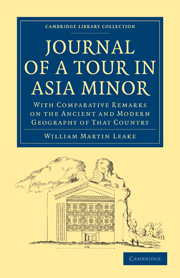 Journal of a Tour in Asia Minor
Journal of a Tour in Asia Minor Book contents
- Frontmatter
- Preface.
- Contents
- Map
- CHAPTER I Journey from Constantinople to Kónia
- CHAPTER II Illustration of the Ancient Gography of the Central Part of Asia Minor
- CHAPTER III Continuation of the Journey.—From Kánia to Cyprus, Alaia, and Shughut
- CHAPTER IV Of the ancient places on the road from Adalia to Shughut, including remarks on the comparative geography of the adjacent country
- CHAPTER V Of the ancient places on the southern coast of Asia Minor
- CHAPTER VI Some remarks on the comparative geography of the western and northern parts of Asia Minor
- Notes
- Index
CHAPTER II - Illustration of the Ancient Gography of the Central Part of Asia Minor
Published online by Cambridge University Press: 13 June 2011
- Frontmatter
- Preface.
- Contents
- Map
- CHAPTER I Journey from Constantinople to Kónia
- CHAPTER II Illustration of the Ancient Gography of the Central Part of Asia Minor
- CHAPTER III Continuation of the Journey.—From Kánia to Cyprus, Alaia, and Shughut
- CHAPTER IV Of the ancient places on the road from Adalia to Shughut, including remarks on the comparative geography of the adjacent country
- CHAPTER V Of the ancient places on the southern coast of Asia Minor
- CHAPTER VI Some remarks on the comparative geography of the western and northern parts of Asia Minor
- Notes
- Index
Summary
Before we pursue our route beyond the capital of the Greek province Lycaonia and of the Turkish kingdom Karamán, it may be right to offer a few remarks upon the general geography of this part of the peninsula, and upon the situation of some of the opulent and celebrated cities which anciently adorned it.
From the sources of the Sangarius and Halys on the north and east, to the great summits of Mount Taurus on the south-west and south, there is an extent of country nearly 250 miles long and 150 broad, in which the waters have no communication with the sea. Its southern part consists of fertile valleys or of extensive plains intersected by a few ranges of hills, and it is bounded to the southward by the great ridges of Mount Taurus, from whence are poured forth numerous streams, which, after fertilizing the valleys, collect their superabundant waters in a chain of lakes, extending from the neighbourhood of Synnada in Phrygia through the whole of Lycaonia to the extremity of the Tyanitis in Cappadocia. In the rainy season these lakes overflow the lower part of the plains, and would often form one entire inundation 200 miles in length, were it not for some ridges which traverse the plains and separate them into several basins. By the structure of the hills, and the consequent course of the waters, these basins form themselves into three principal recipients, having no communication with one another, unless it be in very extraordinary seasons.
- Type
- Chapter
- Information
- Journal of a Tour in Asia MinorWith Comparative Remarks on the Ancient and Modern Geography of That Country, pp. 51 - 92Publisher: Cambridge University PressPrint publication year: 2010First published in: 1824


